Date
of publishing: 26th October 2006
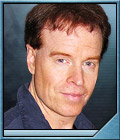 Wes Sargent is a 3D lead animator at "Rainmaker Animation
& Visual Effects" studios, the studio where are
produced a large number of special effects on Stargate SG-1,
Stargate Atlantis and a lot of shows and movies such Dark
Angel, Smallville, Dead Like Me, Firstwave, Andromeda ...
He has worked on the conception of the Atlantis City (Stargate
Atlantis), the Stargates, the Puddle Jumper, several Wraith
ships, the Seberus, and much more. Some of his works are
so detailed that you can't even see them on your screen!
He has worked with Bruce Woloshyn since the early years
of Stargate. His contribution to the Stargate visual universe
is Huge!
Wes Sargent is a 3D lead animator at "Rainmaker Animation
& Visual Effects" studios, the studio where are
produced a large number of special effects on Stargate SG-1,
Stargate Atlantis and a lot of shows and movies such Dark
Angel, Smallville, Dead Like Me, Firstwave, Andromeda ...
He has worked on the conception of the Atlantis City (Stargate
Atlantis), the Stargates, the Puddle Jumper, several Wraith
ships, the Seberus, and much more. Some of his works are
so detailed that you can't even see them on your screen!
He has worked with Bruce Woloshyn since the early years
of Stargate. His contribution to the Stargate visual universe
is Huge!
Gilles Nuytens: How did
you start in 3D modeling?
Wes Sargent: My FX work really began with
the desire to eat something more than craft dinner. I was
always interested in effects from a very young age. A kid
from Vancouver, B.C. seemed very far removed from all the
Star Wars action in Hollywood. So being in a position to
do the fun stuff really didn't happen until the advent of
the personal computer. In the early to mid 90's, CG software
that was being used professionally had just started to become
affordable. After a couple of career hiccups, it seemed
like falling back on artistic talents was a viable endeavor.
I did some research, purchased what I needed and began learning
at home. There are some great schools out there, but for
me the prospect of paying multiple thousands to graduate
with little more than a video tape seemed risky.
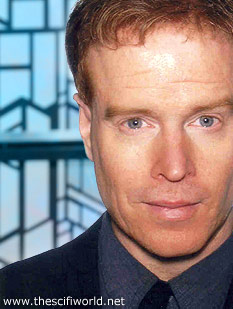 I
wrote a short science fiction script and from there set
about to create shots. The process forced me to problem
solve with a larger story in mind, just like in the real
world of production. Once I had a collection of things I
thought I could show, I went looking for work. I contacted
several FX houses, one in particular helped produce one
of my favorite shows. I offered to create their website,
do interviews, anything just so I could learn how it all
worked from the inside. They were very good to me, answered
my questions and challenged me to push the envelope. I'm
amazed how much time they spent with me, in fact. I've always
been very, very thankful. Every place I sought work from
told me I had to be able to produce shots that were as good
as those already on TV. Hmmm, that seemed rather daunting.
All I had was a 486 pc and very little work experience.
So the next thing I did was try to study and recreate various
FX scenes from shows already on TV. I've seen artists do
that with work we've done here and it is quite flattering.
Imitation is a great way to learn. I'd encourage everyone
starting out to give it a try. From there I landed a few
jobs and finally ended up doing Stargate SG-1 on more of
a regular basis. I
wrote a short science fiction script and from there set
about to create shots. The process forced me to problem
solve with a larger story in mind, just like in the real
world of production. Once I had a collection of things I
thought I could show, I went looking for work. I contacted
several FX houses, one in particular helped produce one
of my favorite shows. I offered to create their website,
do interviews, anything just so I could learn how it all
worked from the inside. They were very good to me, answered
my questions and challenged me to push the envelope. I'm
amazed how much time they spent with me, in fact. I've always
been very, very thankful. Every place I sought work from
told me I had to be able to produce shots that were as good
as those already on TV. Hmmm, that seemed rather daunting.
All I had was a 486 pc and very little work experience.
So the next thing I did was try to study and recreate various
FX scenes from shows already on TV. I've seen artists do
that with work we've done here and it is quite flattering.
Imitation is a great way to learn. I'd encourage everyone
starting out to give it a try. From there I landed a few
jobs and finally ended up doing Stargate SG-1 on more of
a regular basis.
Gilles Nuytens: Who
or what influenced your works, your design sense and your
motivations of making space stuff?
Wes Sargent: There are many good artists
on SG-1 and Atlantis at Rainmaker. I think everyone here
inspires each other, including what is produced by other
vendors. As an example, I learned from friends who did Space
Above and Beyond, if the sun is coming from a certain direction
and it looks good in one shot, but not in another, cheat
it around a bit so that every shot will look as good. That's
not always possible. Sometimes you can see glaring errors
between shots if your not consistent. For example, something
that happens often is where you start out lighting a planet
from one side and then in the next shot you have a reverse
angle. The light would look better going the other way in
the second shot but your locked in so it usually has to
be one way or the other. As a rule of thumb though, whenever
possible, light to make something look great within the
limitations you are presented with. And if there is some
strange mysterious bright light that's making your ship
look pretty good but no one is sure where its coming from,
well then I say be thankful for the off-screen moons.
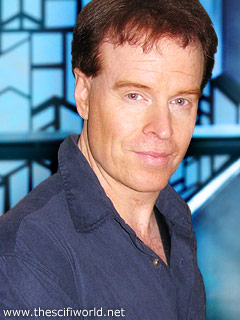 The
same goes for designs. A script or real world physics often
presents you with certain restrictions. You can't just create
whatever you like, it has to serve the story and suspend
some measure of disbelief. But if you can get away with
little cheats here and there to make something look more
appealing, then you try and slip it in....much like aliens
who funny enough, all know how to speak perfect English
every time. The
same goes for designs. A script or real world physics often
presents you with certain restrictions. You can't just create
whatever you like, it has to serve the story and suspend
some measure of disbelief. But if you can get away with
little cheats here and there to make something look more
appealing, then you try and slip it in....much like aliens
who funny enough, all know how to speak perfect English
every time.
Aside from people we work with, films and shows like Space:
1999, Alien, Star Wars, and 2001 still inspire me. That
whole gang from the seventies which included people like
Martin Bower, Brian Johnson, Giger, Syd Mead and the like
caught my attention. When it comes to cool ships and designs,
those were the masters in my opinion. The ships had character,
the designs interesting from virtually any angle. With physical
models, I don't think it costs that much more to gak up
a ship (adding all the little widget details) compared to
digital ships. In CG, the computer has to calculate every
little shape. So what you can get away with in the real
world as far as complex gak can become challenging in ours
depending on the processor power and memory considerations
of course. But then again, we have benefits real world model
makers don't have. We can blow up the same ship without
really destroying it, or clone it a thousand times over
at the touch of a button. Stargate SG-1 and Atlantis has
had it's own look. But in a universe with countless alien
civilizations, there seems to be room for lots choices.
If we have the chance to make some piece of tech look really
detailed, I try to do it and usually we get a favorable
response. If you stand on the shoulders of someone greater
than yourself, you can sometimes see a bit further down
a road. So it is in this business. If we learn to do it
better, it's usually because we learn from each other and
build on those who've gone before.
Gilles Nuytens: What
are your favorite models from Stargate, the favorite that
you built and the favorite made by another artists?
Wes Sargent: There have been many. I enjoyed
building the Seberus, the Goa'uld Mothership, The Tartarus
outpost, both Gates for the two series. One of my first
jobs on 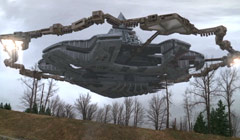 SG-1
was detailing an existing Goa'uld Mothership for "Pretense".
Joe Cruz lit it rather dark so we could get away with allot
but I always wanted to go back and redo the entire ship.
It was originally a Maya model that we ported over to LightWave
and it needed a fair bit of clean up back then. I got the
chance to rebuild from scratch with the SG-1 episode "Orpheus".
You'll notice that the pyramid in the center is larger than
other Motherships. SG-1
was detailing an existing Goa'uld Mothership for "Pretense".
Joe Cruz lit it rather dark so we could get away with allot
but I always wanted to go back and redo the entire ship.
It was originally a Maya model that we ported over to LightWave
and it needed a fair bit of clean up back then. I got the
chance to rebuild from scratch with the SG-1 episode "Orpheus".
You'll notice that the pyramid in the center is larger than
other Motherships.
James Robbins did some nice production art work where the
pyramid was at least 50% bigger than what was in previous
episodes. I went back and forth between his scaled up version
and what we'd seen before. His sizing made those particular
shots look much more interesting so everyone decided to
go with that.
The Daedalus has some very sweet detail for a CG model.
That artist did a great job and we all enjoy using it in
shots.
Marc Roth created the first Stargate puddle effect used
here and later Tom Brydon carried on his legacy producing
a gazillion shots and tweaking it further. Extremely talented
artists who I think deserve awards for the most used effect
ever. Marc later went on to create other amazing water in
the final Matrix movie.
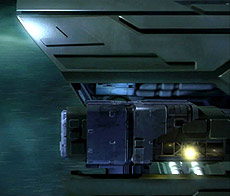 Gilles
Nuytens: How long did
it take you to build the Puddle Jumper? Gilles
Nuytens: How long did
it take you to build the Puddle Jumper?
Wes Sargent: I think about 6 or 7 weeks
in total. There were a couple of trips back and forth to
the studio to get pictures and measurements. The studio
model differs a little from ours but I'm pretty happy with
it overall. The Puddle Jumper seems like a simple ship to
create because it's basically a cylinder, but the paneling
was the more complex aspect. I like to put bevels on most
edges to reduce the hard edged cg look. Depending on the
shape it can all be very time consuming. It pays off in
the end when you get a nice glint from a light or softer
looking shadows. I think the PJ holds up well in the close-ups,
something that can be more of a difficulty in the larger
scale vessels where you start off wide and fly into a small
section of deck plating.
Some of the fun in building the Puddle Jumper was in the
finer details. The original production sketches gave us
a starting point for how the engines should look. It was
a little bit of a problem to figure out how to make them
retract into the body where there really was not a whole
lot of space. If you watch the animation close, you'll see
that there's a little back and forth retraction going on
before the engine compartment finally closes, similar to
what happens on huge aircraft cargo doors where they stutter
a bit before they seal shut.
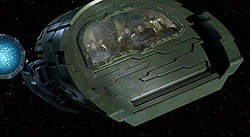 Adding
people to the interior was something that came later. Originally
we had the actors mapped on planes and placed inside the
cockpit. I did a shot in Stargate: Atlantis "Trinity"
where the PJ emerges from the gate and that's where we first
see full 3D characters whose arms, torsos and heads actually
move. When there is time, there's always things we do that
no one asks you for that will sweeten up a shot. That's
satisfying, and it makes our clients happy when we can give
them more bang for their buck. Adding
people to the interior was something that came later. Originally
we had the actors mapped on planes and placed inside the
cockpit. I did a shot in Stargate: Atlantis "Trinity"
where the PJ emerges from the gate and that's where we first
see full 3D characters whose arms, torsos and heads actually
move. When there is time, there's always things we do that
no one asks you for that will sweeten up a shot. That's
satisfying, and it makes our clients happy when we can give
them more bang for their buck.
Gilles Nuytens: Prior
to Stargate, what have you done?
Wes Sargent: Beginning in the 3rd season,
Stargate SG-1 was one of the first shows I worked on. Before
that was a job called Wizards Realm that I don't think ever
got off the ground, The Crow 3 where I built a lamp post....and
hey don't laugh, I got a whopping 400 bucks for that, US
too, lol. I worked on other independent projects where I
just lent a hand or did spec work.
Gilles Nuytens: Outside
of Stargate, what was your favorite show/movie you worked
for and why?
Wes Sargent: That's a tough question. They
were all good for the most part.
When I think of shows outside Stargate I think of the people
I really enjoyed working with. Dark Angel comes to mind
because of Elan Soltes who supervised. He also did the pilot
for Smallville. Elan is a terrific fellow to work for. Very
easy going, hard working, believed in the artists, always
seemed accessible, on task and consequently led the way
to a couple of Emmy nominations for us. Brushing shoulders
with people like David Nutter or indirectly with James Cameron
was a treat. Gary Gutierrez on The Lizzie McGuire Movie
and Adam Buckner on Andromeda was fantastic. Everyone wanted
the shows to look as cool as they could within the limitations
we had and they were great guys so you have fond memories.
Then there are the artists and staff you've worked with
on a daily basis, many SG-1 people like Bruce Woloshyn,
Gary Poole, Tom Brydon, Rod Bland, Simon Ager, Debora Dunphy,
Nick Boughen, Dan Mayer, Jose Burgos, Christopher Stewart,
Lee Pierce, Amanda Schiemann, Naomi Stopa, and new additions
like Judy Shane, Mark Stewart, and Justin Gladden. Apart
from the SG-1 crew and producers we work for, these are
all folks that I know personally have worked very hard and
made significant contributions to the show.
Gilles Nuytens: What
was your part on the movie "I, Robot", the TV
shows "Dark Angel", "Andromeda", "First
Wave", "Smallville" and "Dead Like Me"?
Wes Sargent: For I, Robot I began working
on the final version of robot that demolishes that big house.
Originally it was started by Daniel Osaki in Maya and I
began rebuilding it and rigging it in LightWave, adding
all those nice bevels and details and things like that.
Halfway through, I was called back into service for the
pilot of Atlantis so I had to leave the model in the hands
of two other great artists, Les Quinn and Craig Calvert.
I was sad to see it go, but they did a wonderful job.
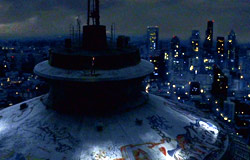 On
Dark Angel, Trevor Cawood and Neill Blomkamp started building
the Seattle Space Needle and I was brought into to help.
After we did the Pilot, they moved on to other things and
I became the lead CG artist for the series. So there was
various kinds of shots that I had the privilege of working
on. I think most if not all the flyby's of the Space Needle
I ended up doing. When we started needle shots we used motion
control. That was a very long process. By the end of the
last season, we were solving our tracking issues and adding
additional camera moves in five to fifteen minutes. Motion
control was eliminated completely. On
Dark Angel, Trevor Cawood and Neill Blomkamp started building
the Seattle Space Needle and I was brought into to help.
After we did the Pilot, they moved on to other things and
I became the lead CG artist for the series. So there was
various kinds of shots that I had the privilege of working
on. I think most if not all the flyby's of the Space Needle
I ended up doing. When we started needle shots we used motion
control. That was a very long process. By the end of the
last season, we were solving our tracking issues and adding
additional camera moves in five to fifteen minutes. Motion
control was eliminated completely.
For Smallville I did various shots and then built Clark's
escape pod. That was an interesting story in itself that
we'll leave for another time. But as I recall, there was
just over a week to come up with a look and construct the
final version. I think it worked okay as a little one man
craft.
In Dead Like Me I built a proscenium for the opening sequence.
Bob Habros, the supervisor was a cool guy to work for too.
I worked on Andromeda for the first couple of seasons.
There were quite a number of shots. Like Stargate, too many
to list but there were some favorite highlights. I would
say the Banshee Fighter which was based on a design, I believe
by Tom Tennisco. Big guns, and big engines, lots of fire
action, big fun. The rear Andromeda Bay was my baby. We
did a sequence where we had a Than fighter being pulled
in on a cable and I built just a floor and some lights.
It went over well and we were asked to expand on it more
for another episode. It became another example of that Star
Warsey kind of look. I think everyone liked it and I was
happy to see it used as a reoccurring stock shot.
I was proud of the Genite ship sequences. Proud we survived
it because we had very few working days considering what
got built. Bruce Woloshyn and I put in some insane hours.
I recall building much of the main ship over the Christmas
holidays. Jim Finn, the FX supervisor came in one day and
said we want a craft that looks like a triangle. Make something
up. Jim gave us allot of liberties, so your mind would always
go, cool, and you go crazy with ideas and gak. When it came
to the final composite where Bruce is adding all the lasers
and pyro, its sort of like Christmas again and you don't
want to leave to go home. Obviously now you look back and
I wish I would have built this better or that, but for its
time I think it did well.
I also built this maintenance robot that I got a kick out
of. It was only was a few pixels high in an actual episode
so no one really got to see it, but I liked that allot.
It was tech but it also was a character.
Gilles Nuytens: Do
you have a favorite software?
Wes Sargent: We use all kinds of software
here, basically whatever we need now. But LightWave is my
program of choice for 3D. It's ideal for quick turnarounds.
It's powerful and a has a fantastic renderer. Photoshop,
well that's just a given.
Gilles Nuytens: Your
favorite scenes/shots?
Wes Sargent: There were so many. When you're
working on something new, often that becomes a favorite.
But looking back I think the Tartarus Outpost from SG-1
"Evolution Part 2" was in the top 10. I was able
to construct this complete 3D exterior environment and interior
and Bruce Woloshyn tarted it up with cool... pardon me,
smokin' hot lava effects and all sorts of other stuff that
made it sing.
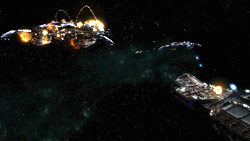 We
did a sequence in "No Man's Land" where the Orion
and the Daedalus are attacking some Wraith Hives. That turned
out rather well I thought. I liked doing the Puddle Jumper
hitting the ocean bottom in "Grace Under Pressure",
the Lava planet in "Lost City" was a favorite
too. I did some initial tests flying over the landscape
in the day and a couple of people were asking me if it was
real footage. They were probably just being nice, lol, but
it the kind of work environment that makes your job pleasurable. We
did a sequence in "No Man's Land" where the Orion
and the Daedalus are attacking some Wraith Hives. That turned
out rather well I thought. I liked doing the Puddle Jumper
hitting the ocean bottom in "Grace Under Pressure",
the Lava planet in "Lost City" was a favorite
too. I did some initial tests flying over the landscape
in the day and a couple of people were asking me if it was
real footage. They were probably just being nice, lol, but
it the kind of work environment that makes your job pleasurable.
Gilles Nuytens: Which
shots and models are you the most proud of and which ones
do you think could have been done better?
Wes Sargent: All the models could have
been done better. It's a matter of time mostly, then money
and experience. As the years go by, I look back on stuff
that was created in earlier days and sometimes I shudder.
But as an artist, you're always improving, computers get
faster which allow you to do more than you could before.
That being said, as efficiency increases, there's often
less time in the budget to complete something. I can't count
the number of times I said, "wouldn't it be cool if
...". There's also story point boundaries you must
work within and design philosophies I like to keep. With
a spaceship for example, the key is to make it look good
from every conceivable angle. That isn't always possible,
but that's what you shoot for.
I think the Wraith ships might have been improved. We have
a few versions, each with their own strengths and weaknesses.
The Hive ship in particular is a massive ship. The closer
you get to it, the more the detail needs to hold up so it
gets tweaked as time goes by in every version we use. But
I like doing shots with those ships and lighting them to
look their best.
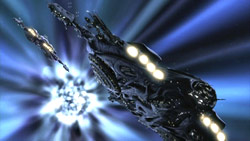 The
original Hive had a different look, more like a two pronged
fork. We were in the process of delivering our final shots
for "Letters from Pegasus" when we got notes that
said we needed to make it more symmetrical. So in the space
of an hour, we made a huge change. I lopped off the left
side completely and mirrored the right side over. Funny
enough, in the opening credits there is a shot of the original
flying overhead. So in the end it was neat to see both versions
on the screen. The
original Hive had a different look, more like a two pronged
fork. We were in the process of delivering our final shots
for "Letters from Pegasus" when we got notes that
said we needed to make it more symmetrical. So in the space
of an hour, we made a huge change. I lopped off the left
side completely and mirrored the right side over. Funny
enough, in the opening credits there is a shot of the original
flying overhead. So in the end it was neat to see both versions
on the screen.
Gilles Nuytens: Isn't
that frustrating to sometimes have to do something that
isn't as good as you could do it because of the time schedule?
Wes Sargent: Always. Time is constantly
a factor no matter what. As much as you try to keep emotionally
detached from work, because this is a commercial industry
where someone else pays for a product they want, if you
spend many hours and invest energy in a certain direction,
it can feel a little frustrating sometimes if a design gets
tossed and you really believe in it. But then again, part
of the job is to make something look great given any direction.
So I try to look at it as something that will stretch you
as an artist, provoke you to think differently. That can
be a win win situation for everyone. All depends how you
look at it. We might get a production drawing and for whatever
reason, once we get it into a 3D environment we find we
might have to alter it. Same goes for the compositors, we
could create something we think works great, and then by
the time it gets into their hands, it might have a completely
different look . . . and from there, a supervisor or one
of the producers or directors on the show might have yet
another take on it. So there is a process and channels to
go through like any organization. But I must say, I've enjoyed
the opportunities over the years to have allot of freedom
to create things for both series, whether its bringing your
design to life or someone else's.
The Seberus was a ship I really liked in "Forsaken"
. . . well all except the nose which lacked the detail,
but we really didn't get to see it much. It was totally
built to fit within the limitations of what was shot on
location, so much of it was hidden from view. Bruce Woloshyn,
again, created some amazing water effects for the take off.
That was impressive. Another facility took what we did and
made their own version for the episode "Space Race"
and the look changed somewhat.
Gilles Nuytens: What
you can realistically create on a TV time line?
Wes Sargent: The time a shot or build takes
really depends on it's complexity. In some cases we might
have a couple of months to put something together, but that
is very rare. If we do we're usually working on a bunch
of other shots at the same time. Most often we'll have only
days. If it's a complex model that is going to be used over
and over again, we tend to have more time because they can
amortize the costs over the course of the series.
Gilles Nuytens: The
time to finish the special effects on an episode can vary
from one to another, which episode was the longest and which
one was the fastest to complete?
Wes Sargent: More often than not, you always
end up spending more time than you thought on something.
You can't go too crazy because there is a budget to follow
and limited amounts of time as mentioned, but we try to
push the envelope as much as we can and give our clients
more than what they expected. I think the pilot episode
for Atlantis was the longest. We had to build everything
from scratch. There's allot of back and forth with producers
and different iterations of things. Everyone wants to get
it right because you're going to be seeing many of these
assets (models) or effects over and over again throughout
the course of the series. The shortest episode I can't say,
probably the one with the least number of effects. From
CG, there was a series of shots where we didn't have allot
of time and we had to construct a satellite. So I created
a very low poly 3D version for the long shots and then doctored
up some photographs for the detailed close up. I put them
on cards and moved them by camera. It worked surprisingly
well I thought.
Gilles Nuytens: How
long does it take for you to complete a matte painting of
a planet or nebula? Could you explain the process and maybe
giving us some tips?
Wes Sargent: Tips, yes. With planets and
nebulas, go big or go home, especially in high definition.
Nebula's tend to be more of the matte painting variety that
we map on geometry. I've used a variety of techniques over
the years to build planets. I can't give away all our secrets,
but I will say they are for the most part, all 3D and they
are built to look good from a distance or fairly close up.
Obviously, the finer the detail, the more computer memory
you may need. If you want to build a good looking planet,
look at lots of NASA photography and start with that. Planets
are one of my favorite things to do.
Gilles Nuytens: You
probably have a lot of designs that never made it to the
screen, can you talk about the history of those designs
and maybe show us some samples?
Wes Sargent: Many of the designs that never
get fleshed out are only a sketch somewhere on a napkin.
Yes I do save them. Some are nearly finished models....and
then there's every stage in between. On a TV budget we can't
afford too much waste, but it's nice when you have a little
bit of time and freedom to explore options.
Here's a preliminary look for the Tartarus Outpost which
you can compare against the version that made it in the
show, and a 5 minute concept sketch for Thor's new Chariot.
All crude starting points but you'll get the idea.
There was a gate fighter that was never asked for, but
I built in my spare time. It was an Earth based spaceship/submersible
plane with retractable wings that initially fit through
the Stargate. The reaction I got around our shop was that
it was very cool, but I don't think there was ever an opportunity
show it much less use it. It had since evolved to the size
of a small bomber, so it no longer fits, but things like
that you still keep on tap for another day.
Gilles Nuytens: How
do you set about to build something?
Wes Sargent: You have to know the context,
what the story requirements are. When you know the range
you have to work within, then you can go nuts. With a spaceship,
I like to start with the nose or the front of the ship.
Like a face on a human being, it's usually going to draw
the most attention. If I can, I like to make a quick sketch,
really rough, and then from that, scan it into the computer
and build a low resolution version. I spin it around in
3D and see how it looks from all angles and then modify
the design accordingly.
Gilles Nuytens: Are
there some stories about some shots, models that could be
fun or interesting for us to know about?
Wes Sargent: Ha Ha, if you only knew. There
are so many. I wonder if we taped the conversations if they
would sell on ebay? Just kidding. I like my job too much.
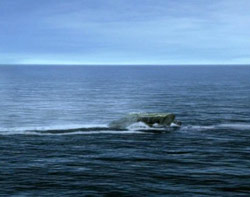 Gilles
Nuytens: Do you watch
Stargate SG-1 and Atlantis? Do you have a favorite episode/story? Gilles
Nuytens: Do you watch
Stargate SG-1 and Atlantis? Do you have a favorite episode/story?
Wes Sargent: I usually watch a cut or two
of an episode before we start our work so I can figure out
what I need to do within the show. Most everyone who works
on Atlantis or Stargate is encouraged to do that. Its a
great thing really because often one person will catch something
that maybe several others have missed. So we all work as
a team. I really enjoyed the writing in Atlantis's "Grace
Under Pressure". That was a favorite and I liked doing
the underwater puddle jumper shots.
Gilles Nuytens: How
do you feel about the cancellation of Stargate SG-1? And
how do you feel about the fan's rally to save the show?
Wes Sargent: Stargate SG-1 had a great
run. As a fan you want to see your show live on indefinitely.
But things change. It's hard to imagine any series going
on forever, but I don't think the fan's rally to save it
is a lost cause. If there is enough interest, anything is
possible. Look at Star Trek. I don't think the SG-1 universe
is dead by any means. I believe Stargate was the most watched
sci-fi show in the world. And Atlantis is a fantastic spin
off in my opinion. So whatever happens next, I think there's
an exciting future still ahead.
Gilles Nuytens: Now,
some questions from fans:
What inspired the Snowflake - design of Atlantis?
Wes Sargent: We did start to build in the
winter months . . . could that have anything to do with
it? I began helping with the model construction near the
end. Quite honestly I'm not sure where that initial design
came from but it ended up looking pretty good don't ya think?
Gilles Nuytens: For
shots coming up to the command level (Balcony) was the interior
model or was that left to the live action to be put in place
for when looking into the command level?
Wes Sargent: Those interiors are live action
photography.
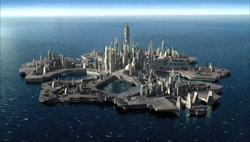 Gilles
Nuytens: How many people
do you have working on a 3D scene, for example the Aurora
fly by a planet. Is it just one guy, doing all modeling,
texturing, etc. Or are these tasks divided among several
artists? Gilles
Nuytens: How many people
do you have working on a 3D scene, for example the Aurora
fly by a planet. Is it just one guy, doing all modeling,
texturing, etc. Or are these tasks divided among several
artists?
Wes Sargent: Depends on the complexity
of a scene, what is required and how much time we have.
It's not unusual for one person to handle a flyby. It's
typically the norm. For the 1st season of Atlantis I was
fortunate enough to do most of the space stuff while other
artists concentrated on the enormous city, landscapes, ocean
builds and other effects. Now that's just the CG department
where we do 3D work. There are also our compositing artists
who seat the CG in the live action photography, add their
own elements and massage and tweak everything to make shots
look polished. Last season Dan Mayer and Jose Burgos, who
were two of our key artists, each designed some shots, lit
them, animated them and did all most of the compositing
work themselves. Not bad I'd say.
Gilles Nuytens: Could
you give us any approximation of the real-world dimensions
for the models. In other words, can you tell us how big
they are supposed to be?
Wes Sargent: I can't give you the specific
details, especial since there are so many, but I can say
that the Wraith Mothership seems to be the largest space
vehicle we see on a regular basis ... to my knowledge anyway.
The Atlantis city seconds that.
Gilles Nuytens: Do
you have some traditional art experience?
Wes Sargent: I never had any real formal
art training no, although I did work as a television camera
man for several years. I did drawing, painting, model making
. . . all the creative things you might do as a kid I brought
with me. I would spend countless hours drawing spaceships,
creatures, and things from my favorite sci-fi shows. Or
I'd draw whatever you might see in the real world: people,
animals, cars, buildings, abstract stuff, mix it up and
maybe as you're lost in thought, you'd come up with a story
to explain it all. I will say, every little drawing I've
tried to keep. Maybe it's the pack rat in me, but you never
know when you'll be searching for some inspiration. The
sketch you did when you were seven might be just what you
need in a crunch. When I was younger, some would come along
and tell me I was wasting my time with all this fantasy
stuff. I don't consider myself a great artist by any means,
but I'm happy to have fun at my job and get paid for it.
I believe God allows people talents to explore and develop.
Sometimes its best, if you can still pay the bills, to just
go where your interests take you. There's always going to
be nay sayers. So when a young person, any age comes to
me to show me his sketch book or other creation, I take
him very seriously. That work, those ideas could be significant
stepping stones in his future. Art, whether in music, on
a canvas or on a TV screen, can help inspire and shape beautiful
visions of a world yet to unfold.
Gilles Nuytens: Is
it possible to have orthographic renders of some Stargate
ships you have build?
Wes Sargent: I'm really sorry to say I
can't. But keep watching the show and checking the magazines.
I suspect there's going to be more ships and more shots
where you can check things out in greater detail.

 You
can now ask your questions directly to Wes Sargent on the
forum!
You
can now ask your questions directly to Wes Sargent on the
forum!
|